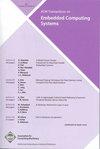Consistency vs. Availability in Distributed Cyber-Physical Systems
IF 2.8
3区 计算机科学
Q2 COMPUTER SCIENCE, HARDWARE & ARCHITECTURE
引用次数: 1
Abstract
In distributed applications, Brewer’s CAP theorem tells us that when networks become partitioned (P), one must give up either consistency (C) or availability (A). Consistency is agreement on the values of shared variables; availability is the ability to respond to reads and writes accessing those shared variables. Availability is a real-time property whereas consistency is a logical property. We extend consistency and availability to refer to cyber-physical properties such as the state of the physical system and delays in actuation. We have further extended the CAP theorem to relate quantitative measures of these two properties to quantitative measures of communication and computation latency (L), obtaining a relation called the CAL theorem that is linear in a max-plus algebra. This paper shows how to use the CAL theorem in various ways to help design cyber-physical systems. We develop a methodology for systematically trading off availability and consistency in application-specific ways and to guide the system designer when putting functionality in end devices, in edge computers, or in the cloud. We build on the Lingua Franca coordination language to provide system designers with concrete analysis and design tools to make the required tradeoffs in deployable embedded software.分布式信息物理系统中的一致性与可用性
在分布式应用程序中,Brewer的CAP定理告诉我们,当网络被分割(P)时,必须放弃一致性(C)或可用性(A)。一致性是对共享变量值的一致;可用性是对访问这些共享变量的读和写作出响应的能力。可用性是实时属性,而一致性是逻辑属性。我们将一致性和可用性扩展到网络物理属性,如物理系统的状态和驱动延迟。我们进一步扩展了CAP定理,将这两个性质的定量度量与通信和计算延迟(L)的定量度量联系起来,得到了一个称为CAL定理的关系,它在max-plus代数中是线性的。本文展示了如何以各种方式使用CAL定理来帮助设计网络物理系统。我们开发了一种方法,以特定于应用程序的方式系统地权衡可用性和一致性,并指导系统设计人员在将功能放入终端设备、边缘计算机或云中。我们以Lingua Franca协调语言为基础,为系统设计人员提供具体的分析和设计工具,以便在可部署的嵌入式软件中进行所需的权衡。
本文章由计算机程序翻译,如有差异,请以英文原文为准。
求助全文
约1分钟内获得全文
求助全文
来源期刊

ACM Transactions on Embedded Computing Systems
工程技术-计算机:软件工程
CiteScore
3.70
自引率
0.00%
发文量
138
审稿时长
6 months
期刊介绍:
The design of embedded computing systems, both the software and hardware, increasingly relies on sophisticated algorithms, analytical models, and methodologies. ACM Transactions on Embedded Computing Systems (TECS) aims to present the leading work relating to the analysis, design, behavior, and experience with embedded computing systems.
 求助内容:
求助内容: 应助结果提醒方式:
应助结果提醒方式:


